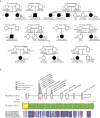Deficiency of ECHS1 causes mitochondrial encephalopathy with cardiac involvement
- PMID: 26000322
- PMCID: PMC4435704
- DOI: 10.1002/acn3.189
Deficiency of ECHS1 causes mitochondrial encephalopathy with cardiac involvement
Abstract
Objective: Short-chain enoyl-CoA hydratase (ECHS1) is a multifunctional mitochondrial matrix enzyme that is involved in the oxidation of fatty acids and essential amino acids such as valine. Here, we describe the broad phenotypic spectrum and pathobiochemistry of individuals with autosomal-recessive ECHS1 deficiency.
Methods: Using exome sequencing, we identified ten unrelated individuals carrying compound heterozygous or homozygous mutations in ECHS1. Functional investigations in patient-derived fibroblast cell lines included immunoblotting, enzyme activity measurement, and a palmitate loading assay.
Results: Patients showed a heterogeneous phenotype with disease onset in the first year of life and course ranging from neonatal death to survival into adulthood. The most prominent clinical features were encephalopathy (10/10), deafness (9/9), epilepsy (6/9), optic atrophy (6/10), and cardiomyopathy (4/10). Serum lactate was elevated and brain magnetic resonance imaging showed white matter changes or a Leigh-like pattern resembling disorders of mitochondrial energy metabolism. Analysis of patients' fibroblast cell lines (6/10) provided further evidence for the pathogenicity of the respective mutations by showing reduced ECHS1 protein levels and reduced 2-enoyl-CoA hydratase activity. While serum acylcarnitine profiles were largely normal, in vitro palmitate loading of patient fibroblasts revealed increased butyrylcarnitine, unmasking the functional defect in mitochondrial β-oxidation of short-chain fatty acids. Urinary excretion of 2-methyl-2,3-dihydroxybutyrate - a potential derivative of acryloyl-CoA in the valine catabolic pathway - was significantly increased, indicating impaired valine oxidation.
Interpretation: In conclusion, we define the phenotypic spectrum of a new syndrome caused by ECHS1 deficiency. We speculate that both the β-oxidation defect and the block in l-valine metabolism, with accumulation of toxic methacrylyl-CoA and acryloyl-CoA, contribute to the disorder that may be amenable to metabolic treatment approaches.
Figures




References
-
- Kanazawa M, Ohtake A, Abe H, et al. Molecular cloning and sequence analysis of the cDNA for human mitochondrial short-chain enoyl-CoA hydratase. Enzyme Protein. 1993;47:9–13. - PubMed
-
- Pougovkina O, te Brinke H, Ofman R, et al. Mitochondrial protein acetylation is driven by acetyl-CoA from fatty acid oxidation. Hum Mol Genet. 2014;23:3513–3522. - PubMed
Grants and funding
LinkOut - more resources
Full Text Sources
Other Literature Sources
Molecular Biology Databases
Research Materials
Miscellaneous

